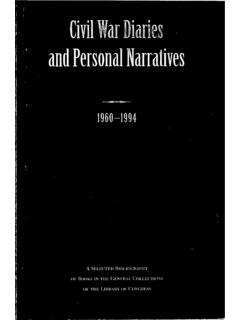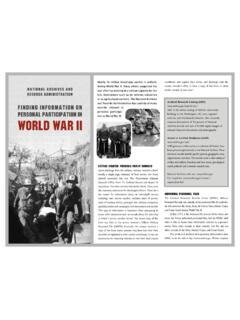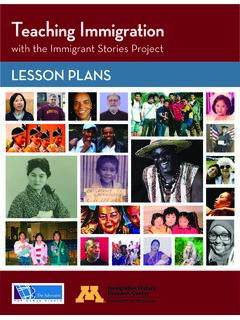Transcription of SAMPLE TEACHING STATEMENTS - Yale University
1 SAMPLE TEACHING STATEMENTST able of Contents(1) History SAMPLE #1(2) History SAMPLE #2(3) History SAMPLE #3(4) Music SAMPLE (5) Political Science SAMPLE (6) Psychology SAMPLE ** Click on the above section title to jump to that SAMPLE #1 TEACHING is exhilarating. I never feel more energized than after a class that has gonewell. I remember feeling that way the first day I taught a seminar. The course was onNationalism in American Politics and Culture, and we began by listening to Nuestra Himna, acontroversial Spanish-language version of the national anthem, and to Toby Keiths Courtesyof the Red, White, and Blue, with its chorus of Well put a boot in your ass, its the Americanway.
2 We looked at various images of Americana, from the Statue of Liberty to paintings ofwestward expansion. Some students were talking, but others remained quiet. I was gettingworried that I was losing them, so I turned off the projector and said, Okay then, everyonethink for a second. Given what weve seen, what is the difference between Nationalism andPatriotism? Lets make a chart. Suddenly, conversation took off. Hands shot up. Answersflew around the room. Students responded to each other. I furiously wrote their ideas ina T-chart on the board. The question I had asked wasnt necessarily the best question, butit was the one they ran with.
3 By the end of class each student was fully engaged. I hadto work really hard to get them there. To keep discussion going, I had to move from songto image to text, searching for the right question. I felt like a prize fighter, bobbing andweaving, looking for the right combination. I was glad that I had prepared not only a PlanA, but also Plan B, C, and D. I had worked hard, it felt great, and I left class on a high forthe rest of the a history teacher, I want my students to make connections. On one hand, I wantthem to develop and articulate a clear and coherent historical narrative: to make connectionsbetween events and people and institutions, to understand the forces of cause-and-effect andchange-over- time.
4 Sometimes the simplest TEACHING techniques can work the best. I usecharts and diagrams and other visual representations to show relationships. My studentsroutinely mention that the timelines we produce in class are their most valuable learningtools, especially the five-layer dip, where we construct a timeline with different categorieslayered on each other in different colors: for example, a twentieth-century civil Rights time-line that places Presidential, Congressional, Supreme Court, African-American, and WhiteSouthern actions in conversation with each other. The visual impact of seeing how theseevents relate is powerful, and students learn that chronology is importantand the same time, I want my students to develop a sense of historical empathy: to makeconnections with their subjects, to understand that history is not just the study of what1happened but also the study of how it happened and of how people understood, explained,and lived with what happened.
5 Sometimes I help my students do this through role-playingexercises. One of the most effective discussion sections I led was for a civil War class,when I split my students into pairs, gave each pair a character such as Spotswood Rice,African-American Union soldier or Godfrey Bainbridge, white southern planter, and askedthe question What was at stake for you in Reconstruction? and then Who might have beenyour ally? And at all times, I supplement secondary source readings with a steady streamof primary source material. I push my students to question these sources, to look past thewords to the people who produced them, to look beyond the images to the context aroundthem.
6 Primary sources always trigger students deeper understanding of the forces of I can help my students put themselves in the place of their subjects, I am one step closerto SAMPLE #2As a teacher, I believe in mixing up my TEACHING based on the material, rather thantrying to fit the material into the same pedagogical box. Some classes are better taughtfocused on a discussion of a single quotation. Others work best by putting five or six authorsin conversation with one another. Others thrive when an image, or a series of images, is thefocal point of the conversation. In each class, at the very least, I try to engage students ina variety of ways, with visuals, sounds, and words.
7 However, I also believe that less can bemore. Each class I lead has a particular goal, and each discussion is the result of carefulpreparation. I dont want my students to leave class with their heads spinning from over-stimulation. I want them to engage the material at hand, and to leave each class with someconcrete understanding. So I also try to end each class with three minutes of I recap for the students and leave them with three thoughts of the day. Othertimes, I ask them to take a moment and write down three things they learned and onequestion they same principles apply to my approach to lecturing; many of the same techniquesare transferrable.
8 I see lecture as a conversation between me and my students, the sources,and the historical narrative. I try to make connections. I try to use images and soundsas well as words and concepts and timelines. I try to push my students to see history asfull of chaos and contingency, full of whats and hows and whys, full of people and eventsand institutions. I think that my greatest ability as a thinker, teacher, and learner is myability to organize my thoughts. Although I try to use a wide variety of sources and addressmultiple concepts, I take great pride in the tight organization of my lectures.
9 What I maylack in intellectual creativity or theoretical gifts, I possess in planning and history for me, then, hinges on the balance between TEACHING content andteaching skills. The two, of course, are related: historical inquiry involves the ability notonly to grasp a certain amount of information, but also to classify, organize, and analyze itand then to convey ones conclusion in clear prose. I try to model this process for studentsin my lectures, and I challenge them to do this in discussions. I especially work with themon cultivating this process in their writing. Precise writing is invaluable but difficult, andrecently I have been focusing my students on two single aspects of their prose: the thesisstatement and the clean paragraph.
10 My favorite exercise is to pull a paragraph from a2reading, cut up the sentences on slips of paper, and ask students to reconstruct the paragraphfrom the separate sentences. Students today are swamped with information from sources allaround them, from blogs to Wikipedia to a 24/7 news cycle to social media. My goal as ateacherand this is also the goal of the humanities, I believeis to help them learn how to siftand analyze this mass of information for ago when I was first trying to decide what kind of job to look for, my father, aneconomics professor at Georgia Tech who loves TEACHING so much that he still teaches threecourses a year, ten years into his retirement, chortled that he wouldnt be much help.











